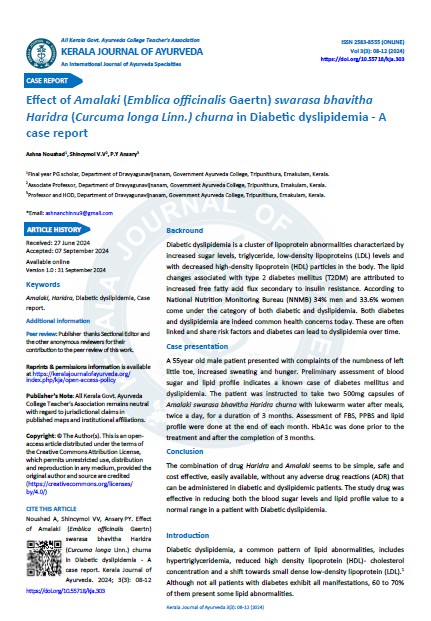Effect of Amalaki (Emblica officinalis Gaertn) swarasa bhavitha Haridra (Curcuma longa Linn.) churna in Diabetic dyslipidemia - A case report
DOI:
https://doi.org/10.55718/kja.303Keywords:
Amalaki, Haridra, Diabetic dyslipidemia, Case reportAbstract
Backround: Diabetic dyslipidemia is a cluster of lipoprotein abnormalities characterized by increased sugar levels, triglyceride, low-density lipoproteins (LDL) levels and with decreased high-density lipoprotein (HDL) particles in the body. The lipid changes associated with type 2 diabetes mellitus (T2DM) are attributed to increased free fatty acid flux secondary to insulin resistance. According to National Nutrition Monitoring Bureau (NNMB) 34% men and 33.6% women come under the category of both diabetic and dyslipidemia. Both diabetes and dyslipidemia are indeed common health concerns today. These are often linked and share risk factors and diabetes can lead to dyslipidemia over time.
Case presentation: A 55year old male patient presented with complaints of the numbness of left little toe, increased sweating and hunger. Initial evaluation of blood sugar and lipid profile suggests as a known case of diabetes mellitus and dyslipidemia. He was advised to administer Amalaki swarasa bhavitha haridra churna capsules (2 x 500mg bd) with lukewarm water after food for 3 months. Assessment of FBS, PPBS and lipid profile were done at the end of each month. HbA1C was done prior to the treatment and after the completion of 3 months.
Conclusion: The combination of drug Haridra and Amalaki seems to be simple, safe and cost effective, easily available, without any adverse drug reactions (ADR) that can be administered in diabetic and dyslipidemic patients. The study drug was effective in reducing both the blood sugar levels and lipid profile value to a normal range in a patient with diabetic dyslipidemia.
References
Wu L, Parhofer KG. Diabetic dyslipidemia. Metabolism. 2014 Dec;63(12):1469-79. doi: 10.1016/j.metabol.2014.08.010. Epub 2014 Aug 29. PMID: 25242435.
Parcero-Valdés JJ. Diabetic dyslipidemia. Cardiovasc Metab Sci. 2021;32(Suppl: 3): s168-172. doi:10.35366/100791.
Rakesh M. Parikh, Shashank R. Joshi, Padmavathy S. Menon, Nalini S. Shah,
Prevalence and pattern of diabetic dyslipidemia in Indian type 2 diabetic patients,
Diabetes & Metabolic Syndrome: Clinical Research & Reviews,Volume 4, Issue 1,2010, Pages 10-12.
Chaudhury, Debasish & Aggarwal, Ankita. (2018). Diabetic Dyslipidemia: Current Concepts in Pathophysiology and Management. JOURNAL OF CLINICAL AND DIAGNOSTIC RESEARCH. 12. 10.7860/JCDR/2018/29009.11090.
Jialal I, Singh G. Management of diabetic dyslipidemia: An update. World J Diabetes. 2019 May 15;10(5):280-290. doi: 10.4239/wjd. v10.i5.280. PMID: 31139315; PMCID: PMC6522756.
Bhavamisra. Bhavaprakasa Nighantu. Pandey G S (ed). Varanasi: Chaukamba Bharati Academy; 2018. Vol 1. p.164.
The Ayurveda pharmacopoeia of India, Government of India, Ministry of Health and family Welfare, Department of Ayush, Part 1, Vol 1.p. 5-6.
Sharma P V, Priya nighantu. Edition (2004). Chaukhambha surbharti prakashan, Varanasi. Haritkyadi varga. p.7.
Pandit Narahari, Tripati Indradeva. Raja Nighantu. 6th ed. Varanasi: Chaukambha Krishnadas Academy; p.174-175.
Kaiyyadeva. translated by Sharma P. V, Sharma G P. Kaiyyadeva Nighantu. Varanasi: Chaukambha Orientalia; 2009. p.205.
Bhavamisra. Bhavaprakasa Nighantu. Pandey G S (ed). Varanasi: Chaukamba Bharati Academy; 2018. p. 111-112.
The Ayurveda pharmacopoeia of India, Government of India, Ministry of Health and family Welfare, Department of Ayush, Part 1, Vol 1.p. 60-61.
Council of Scientific & Industrial Research. The Wealth of India. New Delhi: Council of Scientific & Industrial Research; 2005; Vol 2, p. 275-283.
Krishi Vigyan Kendra Knowledge Network [Internet]. Icar.gov.in. 2019 [cited 2024 Jun 15]. Available from: https://kvk.icar.gov.in.
Lochan K. Bhaishajya ratnavali of Govindadasji bhishag ratna, English translation, Chaukambha Sanskrit samsthan, Varanasi (2005); Vol 1, Chapter 4, p.89.
Agnivesa. Charaka Samhita. R. K. Sharma, Vaidya Bhagwan dash(ed). Varanasi: Chaukhamba Sanskrit series office; 2012. Vol 3 Chapter 6; sloka 4.p.298.
Agnivesa. Charaka Samhita. R. K. Sharma, Vaidya Bhagwan dash(ed). Varanasi: Chaukhamba Sanskrit series office; 2012. Vol 2 Chapter4; sloka 4.p.53.
Madhavakara. Madhava Nidana. (Trans) Chandra Murthy Himasagara, Chaukhamba Sanskrit Series Office, Varanasi; 2012. Chapter 33, Sloka 4; p.1.
Madhavakara. Madhava Nidana (Trans) Chandra Murthy Himasagara, Chaukhamba Sanskrit Series Office, Varanasi; 2012. Chapter 34, Sloka 1; p.20.
Ratnakara. Yogaratnakara. Madham Shetty Suresh Babu(ed.). Varanasi: Chaukhamba Sanskrit Series Office. Volume II; 2010.Rogadhikara. Chapter 40: Sloka 1-47; p.771-776.
Agnivesa. Caraka Samhita. R. K. Sharma, Vaidya Bhagwan dash(ed). Varanasi: Chaukhamba Sanskrit series office; 2012. Vol.1. Chapter 23; Sloka 3-7; p.395.
Srikantha Murthy KR, Bhavaprakasha of Bhavamisra. Chaukambha Krishnadas Academy (2005) edition, Vol 2, Chapter 39, p.503.
Srikantha Murthy KR, Vagbhatas Ashtangahrdyam, Chaukambha Krishnadas Academy, Varanasi (2016), Vol 3, Chapter 40, p.154.
Agnivesa. Caraka Samhita. R. K. Sharma, Vaidya Bhagwan dash(ed). Varanasi: Chaukhamba Sanskrit series office; 2012. Vol 1. Chapter 26; Sloka 43; p.469.
Agnivesa. Caraka Samhita. R. K. Sharma, Vaidya Bhagwan dash(ed). Varanasi: Chaukhamba Sanskrit series office; 2012. Vol 1. Chapter 26; Sloka 42; p.468.
Swathi. M. Somayaji. A clinical study to evaluate the preventive aspect of amalaki swarasa and haridra churna with madhu in pre-diabetes (borderline type2 DM), International Journal of Health Sciences and Research (www.ijhsr.org) 67 Vol.11; Issue: 8; August 2021.
Den Hartogh DJ, Gabriel A, Tsiani E. Antidiabetic Properties of Curcumin II: Evidence from In Vivo Studies. Nutrients. 2019 Dec 25;12(1):58. doi: 10.3390/nu12010058. PMID: 31881654; PMCID: PMC7019668.
Variya BC, Bakrania AK, Patel SS. Antidiabetic potential of gallic acid from Emblica officinalis: Improved glucose transporters and insulin sensitivity through PPAR-γ and Akt signaling. Phytomedicine. 2020 Jul 15;73:152906. doi: 10.1016/j.phymed.2019.152906. Epub 2019 Apr 1. PMID: 31064680.
Kim HJ, Yokozawa T, Kim HY, Tohda C, Rao TP, Juneja LR. Influence of amla (Emblica officinalis Gaertn.) on hypercholesterolemia and lipid peroxidation in cholesterol-fed rats. J Nutr Sci Vitaminol (Tokyo). 2005 Dec;51(6):413-8. doi: 10.3177/jnsv.51.413. PMID: 16521700.
Gopa B, Bhatt J, Hemavathi KG. A comparative clinical study of hypolipidemic efficacy of Amla (Emblica officinalis) with 3-hydroxy-3-methylglutaryl-coenzyme-A reductase inhibitor simvastatin. Indian J Pharmacol. 2012 Mar;44(2):238-42. doi: 10.4103/0253-7613.93857. PMID: 22529483; PMCID: PMC3326920.





